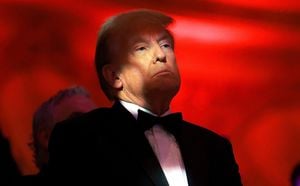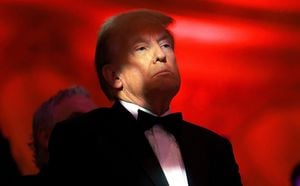Donald Trump's potential return to the White House has reignited discussions about his proposed tariffs, with significant concerns about their economic impact swirling among business owners and consumers alike. His administration’s tariffs during his first term have left many pondering the ramifications of fresh tariffs he has promised should he take office again.
Walmart, the world's largest retailer, has issued cautions about potential price increases due to these tariffs. During recent discussions, Walmart's CFO, John David Rainey, noted, "We never want to raise prices. Our model is everyday low prices. But there probably will be cases where prices will go up for consumers if tariffs are enacted.”
This sentiment aligns with projections from the National Retail Federation (NRF), which suggests consumers could see their spending power drop between $46 billion and $78 billion annually if new tariffs are implemented. The impact of these tariffs could result in widespread economic consequences, echoing concerns exhibited during Trump’s first presidency, when tariffs on numerous products led to increased costs, impacting both businesses and consumers.
Trump's campaign promises painted tariffs as a tool for economic revival, aiming to bring back jobs and manufacturing to the U.S. During his campaign, he floated ideas of imposing tariffs as high as 60% on Chinese goods and up to 20% on imports from other countries, emphasizing the need to restore America’s manufacturing strength. "The word tariff properly used is a beautiful word," Trump emphasized to supporters, asserting it would generate substantial revenue for the U.S. Treasury.
Despite Trump’s grand plans, history suggests otherwise. The U.S. International Trade Commission (USITC) released findings showing tariffs imposed in 2018 effectively lowered Chinese imports by 13% but led to U.S. prices for many products rising by 0.2%. The economic balance appears precarious, demonstrating how tariffs could raise costs for consumers even as they target foreign manufacturers.
Responses from various sectors highlight this complexity. Agriculture has been particularly vocal, initially supporting Trump, yet now many industry leaders are reconsidering their positions. Joe Maxwell, a farmer and former Missouri senator, pointed out, “If the president … fulfills his commitment to increase tariffs up to 20 percent across the board, we're going to pay more than just to put this in the consumers' stores.”
Maxwell's concerns reflect broader apprehensions about corporate monopolies benefiting from tariffs at the expense of competition and consumers alike. He added, "Tariffs only protect the monopolies already existing.” This perspective aligns with sentiments from other farmers who feel the economic realities of tariff implementation might overwhelm their initial support for Trump’s policies.
Conversely, some agricultural sectors are advocating for tariffs as protective measures. Bill Bullard, CEO of R-CALF, which advocates for cattle and sheep producers, sees this as necessary for leveling the playing field against cheaper imports undermining domestic production. Bullard reiterated the importance of tariffs to invigorate the struggling sheep industry, arguing it is indispensable for preventing the continued decline of local operations.
The debate does not merely reside within the agricultural sector. Retail executives, including those from Lowe's, echoed Walmart's concerns about potential cost hikes due to tariffs. Lowe’s CFO Brandon Sink indicated, "Tariffs certainly would add product costs," adding uncertainty about timing and product specifics.
Adding to this uncertainty, economists worry about the overall impact of tariffs and inflation. While Trump asserts tariffs won't lead to inflation, many are not convinced. Past tariffs reportedly pushed inflation during Trump's first term, creating skepticism about similar outcomes following new implementations. Experts venture the potential for inflation to rear its head again, affecting everyday consumers who already feel the pinch from rising prices post-COVID.
The labor market’s resilience and wage growth have contributed to this inflation, prompting the Federal Reserve to intervene with higher interest rates. The push for financial stability is made all the more complex against the backdrop of potential tariffs. Indeed, the reality is the U.S. economy hinges heavily on consumer spending. Should tariffs drive up prices, consumer behavior could shift dramatically, resultantly stifling spending and overall economic growth.
Finally, companies are not merely waiting and watching, but actively strategizing to mitigate potential fallout from these tariffs. Industries have begun rerouting their supply chains as part of their preparation. Reports have surfaced of Chinese manufacturing shifts to Southeast Asia to evade U.S. tariffs. Even with anticipation of tariffs coming down the line, companies appear to be already mapping out strategies to safeguard their business viability.
This reshuffling has led to concerns among lawmakers as well. Republican Senators Joni Ernst and Chuck Grassley have previously voiced their apprehensions over tariffs, highlighting their mixed effects on the agricultural economy they represent. Grassley maintained, "I’m for exporting American goods, not American jobs. Unfortunately, the Biden administration has failed to broker new trade agreements limiting export options for farmers.”
The ensuing battle over tariffs reveals much more than just numbers; it channels the complex interplay of economic guarantees versus potential risks. Trump's tariff plans are undeniably divisive and have sparked wide-ranging conversation among stakeholders from farmers to retail executives. The upcoming months will prove pivotal as businesses prepare for potential changes, and consumers brace for their economic realities, anxiously awaiting how far Trump’s tariff ambitions will stretch.
While promises are enticing, the reality is complex. Are tariffs the solution to restoring American industry? Only time will tell as businesses and consumers face potential new realities fueled by tariff hikes, with their fates intertwined as they navigate the turbulent waters of promised economic policies.



